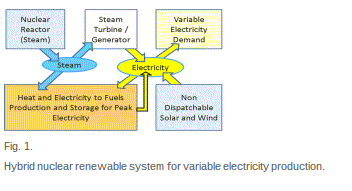

| Visitors Now: | |
| Total Visits: | |
| Total Stories: |

| Story Views | |
| Now: | |
| Last Hour: | |
| Last 24 Hours: | |
| Total: | |
Combining nuclear with artificial geothermal, shale oil, or hydrogen production could help slow climate change
Now may be just the time for this new approach, Forsberg says. “As long as you had inexpensive fossil fuels available for electricity demand, there was no reason to think about it,” he says. But now, with the need to address climate change, curb greenhouse gas emissions, and secure greater energy independence, creative new ideas are at a premium.
While nuclear plants are good at producing steady power at relatively low cost, their output cannot rapidly be ramped up and down. Meanwhile, renewable energy sources are also good at producing power at low operating cost, but their output is unpredictable. Fossil fuel plants can easily be switched on or off as needed, but have higher operating costs and produce greenhouse gas emissions.
One solution, Forsberg suggests, is to find a way to divert excess power from a nuclear plant, making it a “dispatchable” source of electricity — one that can easily be ramped up and down to balance the disparities between production and demand.
The paper outlines three concepts, which Forsberg says could have potential in the coming decades. They involve pairing a nuclear plant with an artificial geothermal storage system, a hydrogen production plant, or a shale-oil recovery operation.
Source: http://nextbigfuture.com/2013/11/combining-nuclear-with-artificial.html



